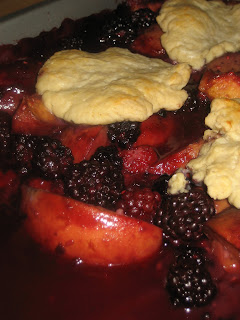 Sometimes I feel that the world of baking has gotten out of control. In search of something new and exciting, increasingly more magazines, cookbooks, and yes, even blogs, have been showcasing excessively "decadent" (read: overdone) dessert recipes. I love a bit of indulgence just as much as the next person, but when I'm beseiged by a horde of Triple Chocolate Caramel Fudge monstrosities, my taste buds shrink in fear.
Sometimes I feel that the world of baking has gotten out of control. In search of something new and exciting, increasingly more magazines, cookbooks, and yes, even blogs, have been showcasing excessively "decadent" (read: overdone) dessert recipes. I love a bit of indulgence just as much as the next person, but when I'm beseiged by a horde of Triple Chocolate Caramel Fudge monstrosities, my taste buds shrink in fear.There's an entire new genre of such baked goods, whose descriptions seem the baking equivalent to letting 4-year-olds pick their own names. Only instead of a world of Princess Rainbow Unicorns and Optimus Michaelangelo Squarepants (forgive the gendered examples), you're left with Banana Berry Brownie Pizza and Coconut Marshmallow Cream Meringue Pie.
So when I glanced at the many varied ingredients for these cookies, I was instantly suspicious. Peanut butter, espresso powder, chocolate, oats, AND hazelnuts? But I was surprised to find that it all came together very nicely in a large, chewy cookie with the air of a regular chocolate chip cookie who just returned after hitchhiking through Western Europe -- simultaneously more worldly (the espresso powder and hazelnuts) and more down-to-earth (the peanut butter and whole wheat flour). I can't quite explain it, but if you're looking for a tasty cookie that doesn't blast your brains out with sweetness, give this a try.
Hazelnut Mocha Cookies
Adapted from Better Homes & Gardens' Christmas Cookies Magazine, 2008
Ingredients:
1 TBS instant espresso powder
1 TBS water
1 1/2 cups smooth peanut butter
1/2 cup butter, softened
1 1/2 cups brown sugar, packed
1 1/2 tsp baking soda
1/4 tsp salt
2 eggs
1 1/8 tsp vanilla
1 1/2 cups regular rolled oats (I use old-fashioned)
1/2 cup whole wheat flour
1 cup dark chocolate pieces (I use ~5 oz chopped bittersweet chocolate)
1 cup hazelnuts, toasted and chopped
To toast hazelnuts:
1. Preheat oven to 350 degrees, F. Spread nuts in a single layer in a shallow baking pan (or on a baking sheet lined with foil).
2. Bake nuts for ~10 minutes (or ~14, if the nuts were stored in the freezer), stirring once.
3. Place the warm nuts on a clean kitchen towel. Rub the nuts with the towel to remove the loose skins. Let cool and chop. Set aside.
To assemble and bake cookies:
1. Preheat the oven to 350 degrees, F. In a small bowl, stir together espresso powder and the water until powder dissolves; set aside.
2. In a large bowl, combine butter and peanut butter with a wooden spoon until well mixed. Add brown sugar, baking soda, and salt. Beat until combined. Beat in eggs, vanilla, and espresso mixture until combined. Beat in oats. Beat in flour. Stir in chocolate pieces and hazelnuts.
3. Drop dough from a 1/4 cup measure (I roll it into balls), 3 inches apart onto an ungreased cookie sheet (line them with parchment paper for ease of clean-up); press each ball slightly.
4. Bake for 13 to 15 minutes, or until edges are lightly browned. Be careful not to overbake. Cool on cookie sheet for ~2 minutes. Transfer cookies to a wire rack; let cool.
Yield: ~24 mondo-large cookies.
To store: Layer cookies between sheets of wax paper in an airtight container; cover. Store at room temperature or freeze for up to 3 months (and when you're ready to serve them, let them thaw on the counter for a few hours until they come to room temperature).




































